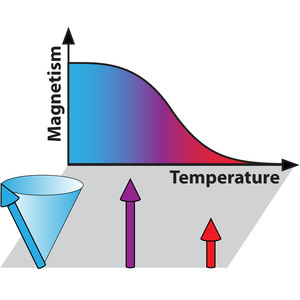There is a general consensus that the essential keys to unraveling superconductivity may be found in the pseudogap phase. A recent idea was put forward suggesting that nano-size electrical current loops, travelling around tiny circuits of only three atoms each, are formed in the pseudogap phase and it is these current loops that give rise to the properties of the phase. The task for the experimentalist consists in tracking down features predicted by these intriguing models.
A high-school student attempting to determine the presence of a loop current might check for the magnetic field that the current must generate. Actually, one expects in each crystalline unit cell two loop currents flowing in opposite directions, producing two anti-paralllel moments. The difficulty here is that the fields, and the size of the loop that generate them, are tiny. Measuring such fields is, however, exactly what neutrons are extremely good at. Like tiny compass needles, they explore the magnetic field on length scales going down to atomic dimensions.
And indeed neutron diffraction measurements could show the presence of magnetic moments within the pseudogap state of high-temperature superconductors (B. Fauqué et al Physical Review Letters 2006). However, after the first positive evidence many questions remained concerning this magnetic order. What about the exact direction of the moments? If the moments are created by Loop Currents then they should be perpendicular to the areas enclosed by the loops. How big are the loops? Is there any correlation between the loops? What is the dependence on materials properties like disorder?

A team of researchers from the Laboratoire Léon Brillouin and the Laue-Langevin Institute has now given a set of surprisingly complete answers to these important questions (Nature Communications 2015). Magnetic signals more than 3 orders of magnitude weaker than the dominant nuclear part could be measured on the instruments 4F1 (LLB) and D7 (ILL) using the method of polarized neutron diffraction. The measurements allowed not only to determine with precision the magnitude of the tiny moments but equally their direction and the extent to which they are correlated in space, Furthermore, they were able to follow all of this as a function of temperature. These results form an eagerly awaited stringent set of conditions on any model that tries to describe the physics of the pseudo-gap phase. They in particular provide us with a way better idea of the form that the postulated current loops may take.
These excellent results demonstrate the unique capabilities offered by polarized neutron scattering. They justify the prominent place that polarization plays in the ILL’s modernization programme Endurance of which D7 is part. Once upgraded the new D7 will allow for a completely new quality of this kind of experiment. Next, the novel polarized neutron diffractometer MAGIC built by LLB and scheduled after 2020 on the next generation neutron European Spallation Source (ESS) in Lund (Sweden) will improve one's knowledge of the loop currents concept.
Reference:
– Intra-unit-cell magnetic correlations near optimal doping in YBa2Cu3O6.85
L. Mangin-Thro, Y. Sidis, A. Wildes & P. Bourges,
Nature Communications 6, Article number: 7705.
Contact LLB: Yvan Sidis et Philippe Bourges.
Collaboration:
- Laboratoire Léon Brillouin, IRAMIS/LLB, UMR12, CEA-CNRS, CEA-Saclay, Gif sur Yvette 91191, France
- Institut Laue-Langevin, 71 avenue des martyrs, Grenoble 38000, France

